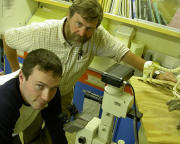



Researcher is betting on bedding as turkey disease cause
GUELPH - Working from the ground up could help one University of Guelph researcher identify the causes of an alarming – and costly – turkey disease.
Researcher is betting on bedding as turkey disease cause - GUELPH - Working from the ground up could help one University of Guelph researcher identify the causes of an alarming – and costly – turkey disease.
Turkey cellulitis – and its milder form focal ulcerative dermatitis (FUD), or “breast blisters” – is the second-most common factor leading to bird rejection among poultry processors. It can affect more than one in 30 turkeys and costs poultry producers and processors thousands of dollars for every lot of birds shipped.
Producers have noticed that turkeys raised on chopped straw litter have a significantly lower incidence of cellulitis than those raised on wood shavings.
Now, Hunter and his research team are comparing animals in the two litters to determine whether or not litter type has any influence on cellulitis incidence.
The research team, which includes agricultural engineers Ron MacDonald and Katie Gibb from Agviro Inc. in Guelph, has set up two groups of birds in two barns, one lined with chopped straw, the other with wood shavings. They’re measuring and comparing several factors – such as pH, temperature, moisture content, ammonia content and bacterial loading – in each type of litter to determine what factors promote FUD, or cellulitis.
The experimental trials in each barn are monitored continuously, with litter samples tested every week and other data in the barn recorded via computer. At set time intervals, Hunter and his colleagues will examine the birds for FUD and cellulitis and rate lesion size and state of advancement, to determine whether any of the litter parameters are related to the occurrence of cellulitis.
Individual trials begin with turkeys at eight weeks of age, usually before FUD or cellulitis is found in the birds.
“We’re monitoring the start of the disease, and looking at how it progresses over the age of the bird,” says Hunter. He also believes that the incidence and severity of cellulitis lesions increases as turkeys age, become heavier and spend more time lying down with their breasts in close contact with the litter.
“We hope to be able to identify the factors in the different types of litter that are responsible for cellulitis,” he says. “And if we can identify those factors, then we may be able to suggest or determine strategies for improving that condition for the animal.”
This research is being sponsored by the Poultry Industry Council and the Ontario Ministry of Agriculture and Food (OMAF) Poultry Research Program.
Source: University of Guelph - Research - 11th September 2003
 Prof. Bruce Hunter, Department of Pathobiology, believes that the litter on which domestic turkeys are raised may be behind turkey cellulitis, a disease that causes the birds to develop large lesions on their breasts.
Prof. Bruce Hunter, Department of Pathobiology, believes that the litter on which domestic turkeys are raised may be behind turkey cellulitis, a disease that causes the birds to develop large lesions on their breasts.
“The theory is that the litter, or something in the litter, combined with the weight and conformation of the birds are the root causes of these lesions,” says Hunter. “So we’re trying to figure out what it is specifically about the litter that leads to these problems.
 Prof. Bruce Hunter and graduate student Chris Enright are searching for the root cause of turkey cellulitis, which they believe may be linked to litter the birds are raised on.
Photo: Paula Bialski |
Producers have noticed that turkeys raised on chopped straw litter have a significantly lower incidence of cellulitis than those raised on wood shavings.
Now, Hunter and his research team are comparing animals in the two litters to determine whether or not litter type has any influence on cellulitis incidence.
The research team, which includes agricultural engineers Ron MacDonald and Katie Gibb from Agviro Inc. in Guelph, has set up two groups of birds in two barns, one lined with chopped straw, the other with wood shavings. They’re measuring and comparing several factors – such as pH, temperature, moisture content, ammonia content and bacterial loading – in each type of litter to determine what factors promote FUD, or cellulitis.
The experimental trials in each barn are monitored continuously, with litter samples tested every week and other data in the barn recorded via computer. At set time intervals, Hunter and his colleagues will examine the birds for FUD and cellulitis and rate lesion size and state of advancement, to determine whether any of the litter parameters are related to the occurrence of cellulitis.
Individual trials begin with turkeys at eight weeks of age, usually before FUD or cellulitis is found in the birds.
“We’re monitoring the start of the disease, and looking at how it progresses over the age of the bird,” says Hunter. He also believes that the incidence and severity of cellulitis lesions increases as turkeys age, become heavier and spend more time lying down with their breasts in close contact with the litter.
“We hope to be able to identify the factors in the different types of litter that are responsible for cellulitis,” he says. “And if we can identify those factors, then we may be able to suggest or determine strategies for improving that condition for the animal.”
This research is being sponsored by the Poultry Industry Council and the Ontario Ministry of Agriculture and Food (OMAF) Poultry Research Program.
Source: University of Guelph - Research - 11th September 2003








